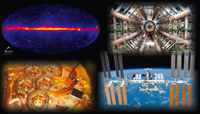Speaker
Douglas Finkbeiner
(Harvard University)
Description
The existence of dark matter has been hypothesized for decades, based on its gravitational effects on galaxies and galaxy clusters, and more recently, by measurements of the cosmic microwave background (CMB) anisotropy. Even though its gravitational effects are hardly subtle, astrophysicists continue to search in vain for any non-gravitational signs of dark matter. In the case of weakly interacting massive particle (WIMP) models, the most promising signals come from ongoing annihilation or decay of WIMPs to Standard Model particles.
I will briefly review the possible astrophysical consequences of WIMP annihilation, and then concentrate on the most rigorous constraint from astrophysics: the effect of WIMP annihilation on the ionization history of the Universe, as recorded in the CMB. I will present our latest work on a robust, model-independent way of parameterizing these constraints, and show expected bounds from the Planck satellite.
